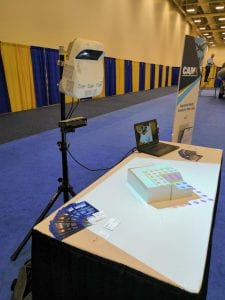In the next few posts we will be discussing some of the hardware choices going from the LayupRITE systems on display at CAMX 2018 and Advanced Engineering 2018 to the version undergoing site trials in 2020/2021. In later series of posts we will be discussing the various software upgrades, updates and changes.

LayupRITE Projected Interactive AR
The projected AR concept of LayupRITE was a development from earlier UoB research on finding improved and novel ways to display information to a laminator on a part-in-progress. The chosen method was using a projector to overlay information onto a part, a type of augmented reality. To make the system interactive it was coupled with a Microsoft Kinect. The Kinect uses both RGB and Depth cameras to track users as “skeletons”. These skeletons can be used to control the virtual projected instructions. The Kinect was also used to calibrate the projector system to align the projected information to the physical surface.

This projected AR experience worked well for the most part. There were some issues with the calibration and alignment not being totally perfect and requiring an oftentimes lengthy setup. However, being able to physically interact with the part and projection data without requiring markers was a definite advantage. It was felt that, with some further development and possibly substituting some components the projected interactive augmented reality (PIAR) system would be an ideal platform for composites layup.
However, with the system as-was at the end of 2019 there were some drawbacks which would need to be addressed. First among which were the setup requirements, both in terms of software and hardware. On the software side, we’ve previously mentioned some of the calibration and alignment issues. The main issue was that the alignment still required manual intervention. Tool tracking was also a planned feature for further development. On the hardware side the 0.2 version required a heavy-duty tank trap and pole-mount setup, which was cumbersome to transport and setup. That said, a solution could easily be designed for a permanent, dedicated workspace.

A second issue was that the interactivity got a lukewarm reception. As mentioned earlier, some substitution would have been required in the future anyway which would be an improvement on the Kinect v2. The third issue was the cost. For the key sector of colleges the cost of the PIAR system was prohibitive for a single-user workstation. This could be mitigated by using a single system with multiple tools and users.
|
Projected Interactive Augmented Reality (PIAR) LayupRITE System |
|
| Pros | Cons |
| Interactive | Too expensive for key customer (without modification) |
| Visible to everyone (unlike head-mounted displays (HMDs)) | Calibration and alignment issues |
| Commercial-off-the-shelf components | Some interactivity issues |
| Runs off regular PC | Kinect v2 requires substitution |
| Cheaper than Laser Ply Projection (LPP) | Not a light-weight, transportable system |
All in all, the PIAR system remains a viable option for LayupRITE. There are still refinements to be made, particularly in the calibration area, but it is felt that this type of AR is probably the optimal method for layup, both training and practice (until we get Expanse-style holograms, of course!)
